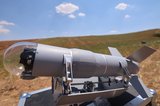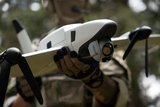Global Hawk flies first operational mission over Canada
For the first time, an RQ-4 Global Hawk remotely piloted vehicle flew its first operational mission over Canadian airspace.
The aircraft was flown April 8 by pilots and sensor operators from the 12th Reconnaissance Squadron.
According to Capt. Kyle Blaikie with the 12th RS, this was first time a Global Hawk flew over Canada on a nontraining mission. A Global Hawk previously participated in the Canadian exercise Maple Flag.
"We used to fly from Beale to Naval Air Station Patuxent River and then down range from there," he said. "This new route utilized the great circle instead of the old rhumb line navigation, which reduces flight time by 37 percent."
Captain Blaikie explained it's more efficient to fly a northern route than to fly in a straight line when traveling long distances.
"When you fly from California to New York, instead of flying straight across the U.S., aircraft will take a northern route because it's less distance due to the curvature of the earth," he said.
The use of the new route over Canada will reduce the time it takes to ferry aircraft back and forth from forward operating locations.
"We need to bring the aircraft back and forth from the desert so that we can perform critical maintenance at Beale." Captain Blaikie said. "The process of taking aircraft from Beale to forward operating locations used to take months, and now we have streamed line this process into a single 26-hour flight."
For this historic flight to take place, 12th RS officials worked closely with those from other countries to obtain the necessary clearances to utilize their airspace.
"I can't say enough good things about our neighbors to the north," he said. "Everyone that I worked with from the Canadian air force to NAV CANADA, the Canadian version of the FAA, were very cooperative in allowing us to accomplish this mission."
This mission showcases the capacity of the Global Hawk to fly long distances.
"No other remotely piloted aircraft can take off and fly 26 hours around the world without midair refueling," he said.
By Tech. Sgt. Luke Johnson - 9th Reconnaissance Wing Public Affairs
More from Uncrewed Vehicles
-
![What's next for the Pentagon after the Replicator programme?]()
What's next for the Pentagon after the Replicator programme?
Although the Replicator initiative has made several accomplishments, there are still multiple gaps to plug across the US Department of Defense (DoD) and its services.
-
![Cummings Aerospace showcases Hellhound loitering munition designed for US Army’s LASSO programme (video)]()
Cummings Aerospace showcases Hellhound loitering munition designed for US Army’s LASSO programme (video)
Cummings Aerospace presented its turbojet-powered Hellhound loitering munition at SOF Week 2025, offering a man-portable solution aligned with the US Army’s LASSO requirements.
-
![SOF Week 2025: PDW unveils attritable FPV drone for SOF operations at scale]()
SOF Week 2025: PDW unveils attritable FPV drone for SOF operations at scale
PDW has revealed its Attritable Multirotor First Person View drone at SOF Week 2025, offering special operations forces a low-cost, rapidly deployable platform for strike and ISR missions, inspired by battlefield lessons from Ukraine.
-
![SOF Week 2025: Teledyne FLIR white paper provides guidance on reusable loitering munitions]()
SOF Week 2025: Teledyne FLIR white paper provides guidance on reusable loitering munitions
Teledyne FLIR is highlighting the emerging requirements for 'recoverable and re-usable' loitering munitions across the contemporary operating environment during this week’s SOF Week conference in Tampa, Florida.
-
![SOF Week 2025: Kraken Technology group debuts K3 Scout USV in North America]()
SOF Week 2025: Kraken Technology group debuts K3 Scout USV in North America
High-performance maritime industry player Kraken Technology Group, based in the UK, has used the SOF Week conference in Tampa, Florida this week to debut its K3 Scout uncrewed surface vessel (USV) to the North American market.
-
![Palladyne AI and Red Cat to demonstrate capabilities for autonomous drone swarms to the US military]()
Palladyne AI and Red Cat to demonstrate capabilities for autonomous drone swarms to the US military
Red Cat and Palladyne AI recently conducted a cross-platform collaborative flight involving three diverse heterogeneous drones.

























